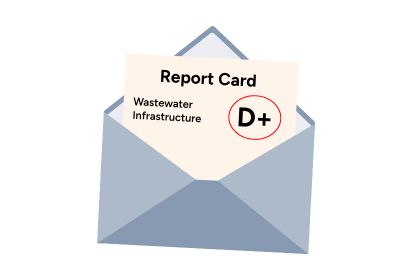How to Bridge the Wastewater Infrastructure Gap
Innovation to Address America’s Wastewater Infrastructure Challenges

The American Society of Civil Engineers (ASCE) recently gave the nation’s wastewater infrastructure a D+ grade. This score is mostly due to aging systems, chronic underinvestment, and growing regulatory pressure. With over 800 billion gallons of wastewater processed daily in the U.S., maintaining reliable infrastructure is essential to protect public health and the environment.
Aging Infrastructure
Across the country, wastewater systems are reaching the end of their intended lifespans. Most treatment plants were designed to operate for 40–50 years. Now, many are now overdue for major upgrades or full replacements. This issue is compounded by decades of declining investment. Capital funding for wastewater has dropped from 3% of utility budgets in the 1970s to just 2% today. As a result, wastewater and stormwater funding is at ~30% of the required capital needs. Those equate to a $69 billion annual funding gap.
The Role of Innovation and Data
To address this shortfall, utilities are being asked to do more with less. Many are turning to innovative tools like advanced asset management platforms, AI, and digital twin technologies to maximize system insights. But collection systems, which often span hundreds or thousands of miles, remain a particular challenge. A single unnoticed defect can lead to a costly and hazardous overflow event. While high-tech solutions offer impressive analytical capabilities, their effectiveness is limited by the volume and speed of the data available. Simply put, you can’t model what you can’t measure. Large-scale data collection is often cost-prohibitive, which means predictive maintenance strategies may fall short in practice.
The Acoustic Inspection Advantage
This is where acoustic inspection fills a needed gap. As a low-cost, low-resolution screening tool, acoustic inspection enables utilities to identify obstructed pipes before sending their high-cost cleaning or CCTV trucks to the area. A two-person team can inspect 10,000–20,000 feet of gravity sewer per day, providing the high-speed, wide-coverage data needed to fuel smarter maintenance decisions – without breaking the budget.
Interested in learning more? Contact us here.